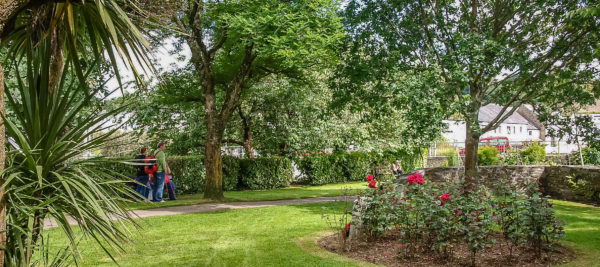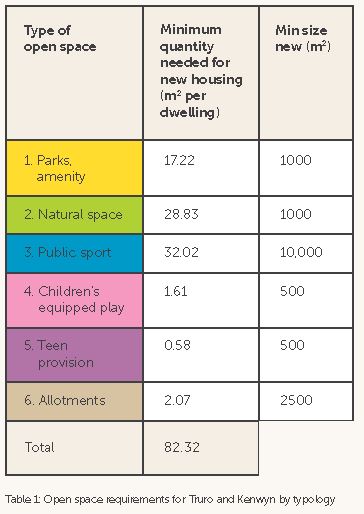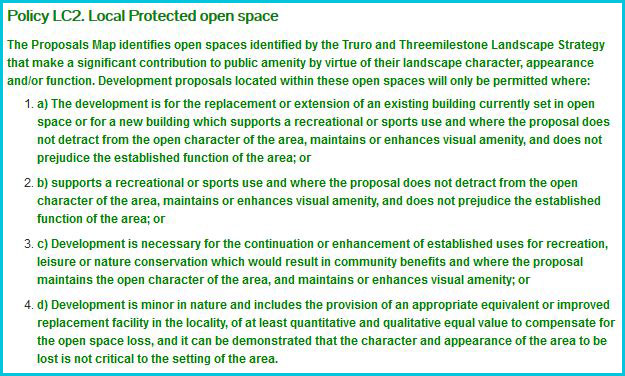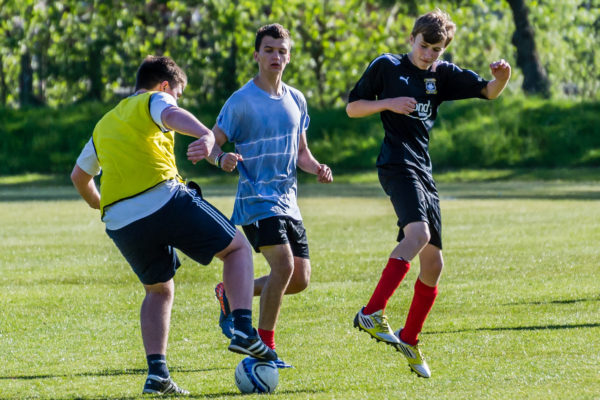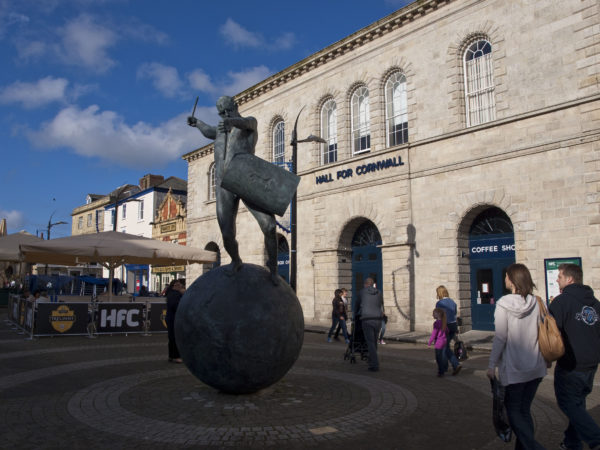Leisure and culture in Truro and Kenwyn:
The quality and quantity of leisure and recreation spaces in the Plan area is a very important factor in the Health and Wellbeing of the community. This is recognised in the County-wide health and wellbeing strategy, and the policies in this Plan represent significant local actions to enact that strategy. Due to the range of spaces, and community centres, from informal open space through to formal pitches a wide range of activities can be accommodated. The Plan will improve access to, and quality of, existing assets in the area for residents in the community, workers who come into the area for employment, and visitors and provide a direct development towards enriching and diversifying leisure and cultural activities in the future. This will benefit those living in the community directly and also increase tourism; an important part of the economy. Truro has a concentration of cultural facilities, including the Hall for Cornwall, Royal Cornwall Museum, the Cathedral and a Cinema. There are a number of community meeting venues in Truro, Threemilestone and Shortlanesend. There are also church halls and some dedicated community centres at Trelander, Malpas and Malabar estates.
The Truro Leisure Centre at Gloweth is the primary venue for public sport and recreation, although this is close to capacity. Schools and Truro City Council provide grass pitches, and the squash and tennis club are private facilities.
What does the plan propose for leisure and culture?
- Better access to recreation:
Better physical recreation opportunities are desired in the area. This includes better walking and cycling trails, crossing facilities for pedestrians and cycles, with new play space created on new developments. This may also be aided by the possibility of opening school facilities on new schools to the public. Water activities should also be considered, allowing the river to be used more. The leisure centre and swimming pool should ideally be replaced by more up to date facilities.
- Community uses:
Facilities should not only be limited to those designed for certain age groups. There is a desire to create new community halls in both the city centre and new developments. The Hall for Cornwall, museum and cathedral will be encouraged to work together with the Community.
All of this aims to promote the community spirit through spaces for leisure and cultural activities, influencing creativity. It should also tie in with the Green Infrastructure Plan and the provision of new growing space in the area.
- Green Infrastructure:
A Green Infrastructure Plan has been created for Truro and Kenwyn. This includes actions that can be delivered with the community to look after existing green spaces and provide new spaces and linkages between our green areas as well as address flooding and wildlife issues.
- Developing shared use facilities: An open spaces audit for the Plan area shows higher than average levels of private sport space (half of which belong to the schools), and that the quality of these sports pitches meets the FiT national guidance. The facilities at Richard Lander and Truro Schools are currently unavailable for community use, and efforts should be channelled into opening them up before considering entirely new provision. In Truro and Kenwyn there is both lower than average allotment space and provision for teenagers.
- Protecting and enhancing open spaces: The Plan allocates local protected green space and open spaces for protection and enhancement. It also identifies new opportunities for allotments and new open spaces. Standards for new spaces are set out alongside opportunities to link existing spaces.
Leisure and Culture policies
LC1. Open space provision
Providing an adequate amount of open space that is easily accessible is important to the community and needs to be achieved in new development within the community. This will maintain easy access to such amenities throughout the community. The priority requirements for each development will reflect the current open space provision in the locality and the type of open space need created by the development.
An open spaces audit of the Truro and Kenwyn area has identified:
- Below average provision of public sports space;
- Slightly above average private and school sports space (although not all of this is accessible by the public
- Allotment space below the average for Cornwall and well below demand levels
- Low levels of teen provision
The evidence base for the Plan includes an assessment of the open space needs for the Truro and Kenwyn area. Based on averages from other settlements and survey work within the Plan area a total requirement of 82.32 square metres for each dwelling is reached. This is summarised in table 1 (below). There may be incidences where it is not possible to provide all open spaces on each site (particularly more strategic natural space and public sport requirements) and therefore although on-site provision is always preferable, some of this requirement will be collected as an off-site contribution to be used for the provision of new or the improvement of existing open space in the plan area.
LC2. Local Protected Open Space
It is important that the creation of new open space does not accompany the loss of existing spaces. Therefore, protecting existing open spaces will play an important part in increasing access to these important areas within the community. The Plan has sought to identify areas of landscape that are important to the community in terms of cultural or landscape value. Those areas are typically part of a cherished view or a green backdrop or foreground to development. The Plan has not sought to allocate broad swathes of land in this designation and recognises that from time to time additional areas of land will be identified. This policy also relates to those areas identified after this plan has been made.
In addition, significant space has been allocated at Coosebean as a strategic open space for the community and an alternative to additional use of Carrine Common for dog walking. Coosebean is land within control of the council to be used by the community. Further measures to enhance this and other important spaces are contained in the Green Infrastructure Strategy.
LC3. Protection of formal and informal open spaces and playing pitches
Formal and informal open spaces and playing pitches form an important focus for community life in the Plan area. They encourage healthy activity, provide much needed green space and help to sustain the life and role of sports clubs from small community groups to larger football, cricket and rugby team provision. In some cases clubs have created additional facilities that help provide the means to maintain the facilities and provide additional community facilities that otherwise would not exist. The viability of clubs is also reliant upon the standard of facilities provided, such as spectator accommodation and/or clubhouse, which are also vital elements to ensure viability for future provision. For this reason a policy is required to ensure that these areas are protected from development, other than where the proposal would help to enhance the facility or re- provide it in a location that relates well to the community and is accessible via a variety of transport modes including walking, cycling and bus transport to ensure that sports clubs are accessible to the whole community.
The Open Spaces Study that was undertaken to provide evidence for this Plan has shown that there is an under-provision of public sport space in the plan area. The shared use of private sports provision in schools is encouraged, but it is recognised that this Plan cannot require this on existing schools. The Plan therefore continues to seek the provision of new public sport. Some facilities, such as formal sports pitches are difficult to recreate due to site specific requirements (e.g. the amount of well-drained flat land required) and long preparation times. Recognising the often pivotal role sports clubs and open spaces play in the life of communities, it is important to make sure that where these sort of facilities are re-provided that they are accessible by the communities that they serve and offer at least an equivalent, if not enhanced, standard of provision.
LC4. Cultural and community centres and services
The provision of cultural and community centres and services are essential to community life and help to bind us together in our communities through shared identity and interests. New cultural and community centres and services are encouraged through this Plan and support will be given to new proposals advanced to provide them.
The Plan is keen to ensure that there is fair access to community centres, services and facilities across the whole of the Plan area. This is particularly important in areas of concentration of social housing and there has been investment in facilities in these areas. Statistics show that relatively high levels of deprivation exist at Hendra, Malabar, Trelander and Malpas, although other parts of the Plan area such as Threemilestone and the city centre suffer from pockets of deprivation and from poor access to facilities. The Council will seek to apply development contributions to meet the community needs in these areas and other locations where a need for such facilities is demonstrated.
Sustainability
These policies aim to contribute to sustainable development by:
- Promoting accessible open space close to where people live
- Providing new food growing spaces through allotments
- Protecting important spaces and views
National Planning Policy Framework (NPPF):
NPPF4: Promoting sustainable transport;
NPPF7: Requiring good design;
NPPF8: Promoting healthy communities
NPPF10: Meeting the challenge of climate change, flooding and coastal change
NPPF11: Conserving and enhancing the natural environment
Cornwall Local Plan:
1: Sustainable development
12: Design
13: Development Standards
21: Best use of land and existing buildings
25: Green Infrastructure
27: Transport and accessibility
Who will assist with delivering the aims of Leisure and Culture policy?
- Local Nature Partnership;
- Cornwall Council;
- NHS;
- Voluntary and charity sector
- Leisure providers;
- Education providers;
- Private Sector providers/businesses;
- Land owners and developers.
- Local Action Group funding

